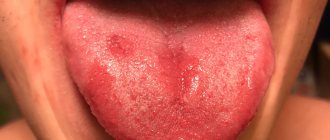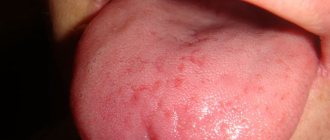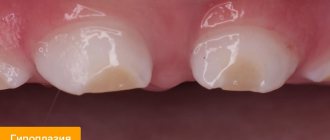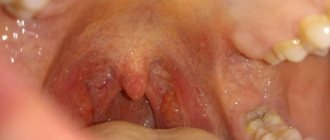Recurrent aphthous stomatitis
Recurrent aphthous stomatitis is a chronic pathology characterized by inflammation of the oral mucosa. Its main symptom is a rash of aphthae or ulcers, which are noticeably painful. Aphthae usually appear periodically in the following areas:
- Language;
- Cheeks;
- Hard and soft palate;
- Mucous membrane of the lips.
If ulcers are periodically injured, they can develop into full-fledged, difficult-to-heal wounds, in place of which noticeable scars remain. The normal healing time for aphthae is no more than a week from the moment of its appearance.
The prerequisites for the occurrence of aphthous stomatitis are as follows:
- Chronic colitis;
- Diseases of the nervous system;
- Chronic stress;
- Injury to the mucous membrane;
- Hormonal imbalance during menstruation.
With a normally functioning immune system, ulcers heal on their own in one, or in extreme cases, two weeks. If healing does not occur, you must visit a doctor to prescribe the correct treatment. As a rule, the basis of therapy is taking vitamin C, which has a positive effect on the immune system.
Herpetiform stomatitis
Herpertiform stomatitis is characterized by the appearance of numerous ulcers on the oral mucosa, which in appearance resemble ordinary herpes. Girls under 30 are at risk - they are the ones who suffer from pathology more than others. Locations of the disease:
- Underside of tongue;
- Floor of the oral cavity.
Ulcers heal in no more than 10 days from the moment they appear, leaving no scars. Treatment, as in the case of the previous type of stomatitis, is based on the use of vitamin C. The dosage and regimen of medications is prescribed by the attending physician.
How can you get rid of sores in your mouth?
How to treat wounds in the mouth if they appear and cause discomfort. Initially, you need to determine the true causes of their occurrence. This will help not only choose the right treatment, but also reduce the risk of relapse. If simply stomatitis has formed, it is not difficult to recognize it, but a purulent wound in the mouth of unknown pathogenesis is a reason to consult a doctor. Particular attention should be paid to lesions that do not heal for more than 10 days.
For a quick recovery, use:
- medicinal ointments with anti-inflammatory effect;
- antibiotics if the cause is a bacterial infection;
- complex of vitamins;
- rinsing with oral antiseptics;
- protective applications;
- painkiller injections;
- laser cauterization.
Recurrent necrotizing peryadenitis
Recurrent necrotizing peryadenitis is also called Setton's aphthae. Its symptoms are:
- Seals appear in the submucosa of the oral cavity;
- Instead of compactions, ulcers with raised edges develop over time;
- The ulcers become inflamed, causing blood and lymphatic discharge.
Places where such afts accumulate are the upper and lower lips, cheeks and sides of the tongue. The pathology is characterized by extremely severe pain. Patients find it so difficult to eat that many give up eating completely. Difficulties also arise during conversation. The healing process of aphthae lasts a long time - sometimes up to several months, and the pathology itself persists for up to several years.
Afty Bednar
Bednar's aphthae is the appearance of small wounds on the oral mucosa. The pathology manifests itself exclusively in children due to poor hygiene or accidental injury.
The location of the ulcers is the palate. They have a slightly yellowish coating and heal quite quickly - up to 5 days. For the pathology to go away, it is enough to normalize oral hygiene.
The gums become inflamed due to insufficient oral hygiene and lack of regular visits to the dentist. The result is an excessive accumulation of plaque on the teeth and pathogenic microorganisms. Pathogenic microorganisms trigger a process in which their own toxins and inflammatory mediators are generated. Treatment of diseases of the mucous membranes and gums with the Vector device
Traumatic mouth ulcers
The name of traumatic ulcers speaks for itself. This is the appearance of wounds in the oral cavity due to injury to the mucous membrane. The causes of injury may be:
- Bite of the mucous membrane;
- Accidental contact with a toothbrush;
- Inaccurate dental treatment.
One of the types of traumatic ulcers are prosthetic ulcers - wounds formed due to incorrect sizes of removable dentures. They are localized precisely under the dentures.
Healing of traumatic ulcers lasts 1-2 weeks. As a rule, this is a one-time pathology that goes away on its own without additional treatment. Such aphthae are painless and small in size.
If a complication of the disease nevertheless begins, it is necessary to visit a doctor so that he can prescribe anti-inflammatory and antibacterial medications to completely eliminate the pathology.
Causes of lesions in the mouth
To determine how to treat a pathology, you must first find out why it appeared. In most cases, ulcerative lesions occur against the background of reduced immunity, lack of vitamins and microelements, in particular iron and folic acid. The most common causes of ulcers:
- Different types of stomatitis. The aphthous form of the disease is accompanied by the appearance of white or yellow lesions in the center with a red border. Such wounds are 0.3–1 cm in diameter. Pain during the disease is often moderate, in some cases it is severe. If large wounds form, a careful approach to treatment is needed. With candidal stomatitis, caused by fungi of the genus Candida, the ulcers are covered with a characteristic cheesy coating.
- Injury to the mucous membrane. Various factors can provoke a pathogenic process: mechanical influence (with an incorrectly installed filling, caries, improper fitting of dentures, etc.) or thermal (eating hot food), chemical (smoking, exposure to caustic drugs). Even a simple bite of the cheek or tongue injures the tissue. In a child who frequently sucks his thumb, ulceration may occur on the soft palate. The habit of biting nails and pencils also provokes the formation of microtraumas. When they get infected, inflammation develops.
- General diseases of a systemic or chronic nature (disorders of the gastrointestinal tract, tuberculosis, syphilis and HIV, blood diseases). In rare cases, the cause of their formation is oral cancer. Viral diseases also provoke ulcers. Sore throat and tonsillitis can cause lesions on the tonsils.
White sores on the oral mucosa are sometimes a consequence of taking certain medications. They are also formed when there is insufficient saliva production. The problem can be provoked by the use of toothpastes containing sodium lauryl sulfate and triclosan.
Tuberculosis of the oral mucosa
Tuberculosis of the oral mucosa is a complication of standard pulmonary tuberculosis. The cause of the pathology is the penetration of bacteria into the oral cavity through damaged soft tissues. Localization of ulcers occurs in the following places:
- Cheeks;
- Language;
- Floor of the oral cavity.
At the affected sites, standard tuberculous tubercles first form, and then ulcers appear in their place. They do not heal and gradually increase in size. Aphthae are shallow, but very loose with slight bleeding. Their edges are soft, but despite this, the ulcers are noticeably painful.
Usually, along with the appearance of tuberculous ulcers, the patient feels a general deterioration of his condition, which manifests itself in the following symptoms:
- Loss of appetite and weight;
- The appearance of a white coating on the tongue;
- Sweating;
- High body temperature.
Treatment of such a pathology involves staying in a special closed dispensary. As a rule, during the period of weakening of the symptoms of the disease, sanitation of the oral cavity is carried out, as well as treatment with anti-inflammatory and antibacterial drugs.
Syphilis
Syphilis is an infectious pathology caused by Treponema pallidum. Mouth ulcers are a typical symptom of syphilis that appears throughout the entire period of the disease. Moreover, the ulcers themselves undergo a certain development process:
- The ulcers are round in shape and have dense edges. They are painless and have a white coating.
- Over time, the ulcers begin to bleed slightly.
- After about 1-3 months, the ulcers heal, and in their place strong scars form, around which dense bluish edges are concentrated.
After defeating syphilis, dense scars still remain in the oral cavity. They are the most eloquent sign of a recent illness.
Treatment of syphilis is carried out in a closed venereology clinic. During remission, the oral cavity is treated with anti-inflammatory and antibacterial drugs.
What to do if a white sore appears in your mouth
If ulcerations are detected, you should contact your dentist, especially if they do not heal on their own. The doctor will tell you how to treat the wounds, comparing the problem with the causative factor. The following drugs are most often prescribed:
- Antiseptic solutions for rinsing: “Chlorhexidine” 0.05%, “Miramistin” 0.01%, “Furacilin” (a prepared preparation that does not require dilution). It is important to take into account the concentration of the active substance so as not to get a burn to the oral cavity.
- Anti-inflammatory drugs. To eliminate white ulcers in the mouth, alcohol tinctures from medicinal plants are used. For example, “Chlorophyllipt”, “Stomatophyte”. If a white sore appears in a child, gels (Metrogil Denta, Cholisal) are prescribed, which also have an analgesic effect.
- Antibacterial agents. Prescribed if ulcers are caused by bacteria (tuberculosis bacillus, streptococci, etc.).
- Antifungal agents. Fluconazole and Ketoconazole effectively combat fungi.
Any medications can be taken only as prescribed by a doctor. Self-medication can cause complications! To speed up the action of drugs, electrophoresis, phonophoresis or laser treatment methods are prescribed.
In addition to the complex of drug therapy, you can rinse using decoctions based on medicinal herbs (chamomile, oak bark, sage, calendula). Sometimes a course of vitamins and immunostimulating drugs is also prescribed, especially if the ulcers are chronic.
Acute necrotizing gingivostomatitis
Acute necrotizing gingivostomatitis is a viral infectious pathology in which ulcers form on the surface of the entire oral mucosa, including the tonsils. The prerequisites for this disease are:
- Deterioration of the immune system;
- Injury to the oral mucosa;
- Lack of vitamins and minerals in the body;
- Chronic severe fatigue;
- Sudden hypothermia;
- Complication of ordinary stomatitis or viral pathologies.
The risk group is mainly men under 30 years of age. Ulcers are wounds with a loose bottom, uneven edges and a dirty green coating, which has an unpleasant odor and can be easily removed if desired. All the soft tissues around them are swollen and inflamed, and the wounds themselves bleed slightly. As a rule, the appearance of such ulcers is accompanied by the following symptoms:
- Acute pain while eating and talking;
- Very bad breath;
- Heavy secretion of saliva;
- A sharp increase in body temperature;
- Swelling and soreness of the gums;
- Bleeding gums;
- Yellowish plaque on the surface of the gums.
Treatment of the disease should be carried out under the strict supervision of the attending physician. The treatment regimen depends on how poorly the patient feels and at what stage the disease is. Typically treatment involves the use of:
- Broad-spectrum antibiotics;
- Antiallergic drugs;
- Vitamins C and R.
Additionally, the inclusion of high-calorie food and drink in the diet is prescribed. Sometimes, if necessary, heart medications are added to the treatment regimen.
Local treatment of pathology is also carried out by surgical removal of damaged tissue under anesthesia. After this, the oral cavity is treated with anti-inflammatory, antiseptic drugs, as well as a solution of white clay. When a positive result is achieved, professional oral hygiene is performed.
Symptoms of ulcerative lesions of the oral mucosa
An oral ulcer is a sign of pathological processes occurring in the body. It looks like a round or oval wound with uneven, soft edges and a loose bottom. The tissues swell. Such lesions can be single or multiple. The localization locations are different: under the tongue or on it (especially at the edges), on the cheek, palate, in the throat, on the inside of the lower or upper lip, on the mucous gingival tissues. Symptoms that may accompany the formation of ulcers:
- itching felt in the affected area;
- bad breath;
- pain when eating;
- increased body temperature;
- increased salivation.
Mouth ulcers can occur in adults and children. When they form, the layer that is responsible for restoring the integrity of the gums is affected. In most cases, the ulcers do not reach large sizes and disappear after 2 weeks. Improvement should be observed within 7 days. If unpleasant symptoms do not go away, or their severity increases, you should consult a doctor.
HIV infection
Oral ulcers are a common symptom of HIV infection and occur in approximately 30% of patients. In this case, their treatment is very specific. An infectious disease doctor selects a treatment regimen and medications for each patient individually. Sometimes ulcers are considered normal and do not require treatment, but this happens extremely rarely and only in advanced stages of the disease.
The patient can also go to any public dental clinic for surgical removal of ulcers. But before that, you need to make sure that there are no negative consequences after such surgery. If removal is justified, it is carried out in accordance with all precautions.
Prevention of oral ulcers
Prevention of any type of ulcers is always the elimination of the root cause of their appearance. If ulcers are a symptom of infectious diseases, it is necessary to prevent the pathogen from entering the body. If this is the result of poor oral hygiene, you need to pay more attention to it. It is also worth visiting your dentist for advice on proper hygiene.
At least once a year, experts recommend visiting a dental clinic for professional oral hygiene. So, mouth ulcers can be a sign of many diseases. To determine the reason for their appearance in more detail, it is necessary to pay attention to the location of the ulcers and their appearance. To treat diseases, it is better to consult a doctor. Self-medication may not only not lead to the desired results, but also aggravate the situation due to the lack of correct therapy.
Causes of sores in the mouth
Purulent ulcers in the mouth can appear for various reasons. They are often the result of dental diseases.
The list of reasons may include the following:
- viral infections (herpes simplex or herpes zoster);
- fungal and bacterial infections;
- irritation of the mucous membranes from smoking and certain foods (nuts, cheese, citrus fruits);
- ulcerative stomatitis;
- chemotherapy drugs;
- frequent stress and nervous tension;
- oral injuries;
- hormonal changes.










